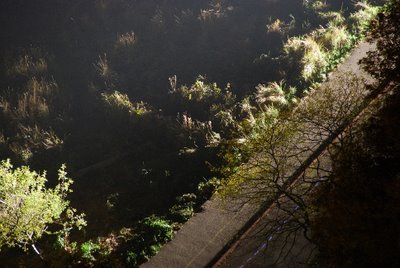 False Creek Magic Light
False Creek Magic Light
Oct 23 2006
One of the first things I discovered when I embraced photography as a hobby was that taking a picture is, in essence, painting with light. I don't expect that I'm the first photographer to realize this but when that particular realization struck me it radically changed how I looked through the camera's view finder.
Don't get me wrong, I still love to point and shoot whatever the moment brings but as a nature/landscape photographer when I get serious and spend the time to first embrace, then frame and then finally configure a photograph it's all about light.
I was pretty thrilled then when a week ago, as happens two or three times a year, a local film crew setup their lighting gear on Sunset Beach to shoot some exteriors on the other side of False Creek. Night became day and I had a front row seat on thousands of bucks worth of magic light.
This time I opted for high vantage point shots rather than venturing down to the beach for some close ups. The light and the compositional opportunities were pretty endless from 32 floors up and I spent a third of the 104 shots doing that cheesy but fun expose & zoom trick. Having already subjected this blog to the results of this technique I'll skip including any of them with this entry. .... Must ... resist ... must ... :)
Anyway, with a 10 mega-pixel camera I now shoot at a resolution of 3,872 by 2,592 pixels. This is roughly the number of pixels you would find on seven and half 19" LCD monitors running at their native resolution of 1280 by 1024.
JPG images take up roughly 4 MBytes and Nikon's native RAW format (what they call NEF) produces an image that comes in between 9 and 11 MBytes. Thank goodness for 2 Gbyte memory cards. Being able to shoot at such a super high resolution however is a two edge sword. When an image is displayed at it's native resolution I can instantly pick up even the slightest of blurry imperfections. Grumble.

What I've discovered is that when taking long exposure high resolution shots, even when the camera's mounted on a nice solid tripod with a locked down ball style mount, 10 seconds or more of settling time is needed before I should press the shutter on the cable attached remote shutter release. The shot above was taken at an aperture of F5.6 and exposed for 3 seconds with an auto-ISO setting of 400. It was also taken about 30 seconds after I'd taken the first shot in this sequence which turned out to be blurry enough to be pretty much useless. Patience grasshopper. Compose, take 2 deep breaths then click the shutter release cable.
All part of the never-ending learning curve that is any cool hobby. :)



1 comment:
Cool night shot. They should set up those lights more often. Great Blog Bro!
Mike.
Post a Comment